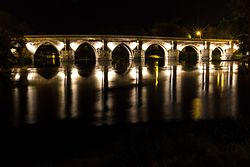The Roman bridge of Lugo crosses the Minho river in Lugo, Galicia. The bridge is of Roman origin and has been rebuilt many times in its history.[1]
| Roman bridge of Lugo | |
|---|---|
Puente Romano de Lugo | |
| Lugo Near Lugo in Spain | |
 The Roman bridge at night | |
| Type | Ancient Roman bridge |
| Length | 104 metres |
| Site information | |
| Open to the public | Yes |
| Website | www |
| Site history | |
| Built | 1st century |
| Built by | Roman culture |
| Materials | stone and slate |
| Bridge width 4 metres | |
The bridge was open to traffic until 2012. It was then closed to all vehicles and converted to a pedestrian-only footbridge. The roadway and modern superstructure was replaced with contemporary stonework to complement the bridge's original features.
Features
editThe structure is made primarily of stone and slate, with added metallic walkways. The surface was paved, allowing for continuous vehicle passage, with the exception of heavy vehicles, which were not permitted to cross.
It was a frequently used bridge, given its proximity to the Lugo Fluvial Club, among other recreational facilities, and to the Lucense Polyclinic. It was also the most logical route to the Portomarín road or the Lugo Golf Club. Following the construction of the new bridge over the Miño, traffic was diverted to a newly created route for that purpose. [2]
Currently, this bridge is one of the two pedestrian bridges the city has to offer.[3]
History
editThe bridge was designed and built during the Romanization of Galicia. It utilized route number XIX of the Antonine Itinerary, connecting Lucus Augusti with Bracara Augusta (present-day Braga) and passing through Iria Flavia (the current town of Padrón). The reason for its construction was the need to cross the Miño River.
Centuries later, during the Late Middle Ages, the bridge underwent significant restorations. This was partly due to its deteriorating condition and also to meet the new transportation needs of the era. With the onset of the Modern Age, further repairs were once again necessary. Ultimately, in 1893, its appearance was definitively altered by the removal of several elements. However, the foundations of the current bridge, often referred to as the "old" or "Roman" bridge, largely remain original.
Due to the construction of a new bridge in 2009, the Roman bridge of Lugo was restored and designated for pedestrian use. During the restoration process, the metallic walkways were removed and the asphalt surface was taken out, with efforts made to make it resemble as closely as possible its appearance during Roman times.[4]
Route from the city of Lugo to the Roman bridge
editThe Calzada del Puente, which descends from the Puerta Miñá or Puerta del Carmen (one of the ten gates of the city wall, and also one of the five original ones that is best preserved) to the Roman bridge, is part of the Primitive Pilgrimage Route to Santiago de Compostela. This is also where the hiking route "Las ribeiras altas, Miño arriba" begins, popularly known as the "Paseo del Puente Viejo." This route stretches over eleven kilometers along both banks of the river, heading towards the old light factory.[5]
Gallery
edit-
Bridge when it was still open to traffic c. 2008
-
The pedestrianised bridge in c. 2019
See also
editReferences
edit- ^ "The Roman bridge of Lugo on lugoaccesible.net". www.lugoaccesible.net. Retrieved 27 November 2022. (in Spanish)
- ^ Blanco, José. [1]. El nuevo puente sobre el Miño en Lugo ya es realidad
- ^ El puente romano [2]. Archived from the original on May 1, 2016. Accessed on October 12, 2023.
- ^ [3]. El puente romano de Lugo no se rehabilitará hasta el próximo verano
- ^ [4]. Rutas Turísticas: Las ribeiras altas, Miño arriba
External links
editMedia related to Old Bridge of Lugo at Wikimedia Commons